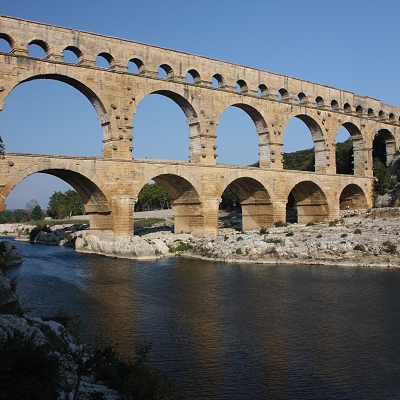
Like us on Facebook
PLACE NAMES


 
|
|
Remoulins
|

| |
Remoulins is a commune in the Gard department in southern France.
The Pont du Gard is located in nearby Vers-Pont-du-Gard. The bridge over the Gardon River can be accesssed from the north or south from the village of Remoulin.
Pont du Gard is an ancient Roman aqueduct bridge built in the first century AD to carry water over 50 km (31 mi) to the Roman colony of Nemausus (Nîmes). It is the highest of all Roman aqueduct bridges, as well as one of the best preserved. It was added to UNESCO's list of World Heritage sites in 1985 because of its exceptional preservation, historical importance, and architectural ingenuity.
The bridge has three tiers of arches made from Shelly limestone and stands 48.8 m (160 ft) high. The aqueduct formerly carried an estimated 40,000 m3³ (8,800,000 imp gal) of water a day over 50 km (31 mi) to the fountains, baths and homes of the citizens of Nîmes. The structure's precise construction allowed an average grade of 1 cm (0.39 in) in 182.4 m (598 ft). It may have been in use as late as the 6th century, with some parts used for significantly longer, but a lack of maintenance after the 4th century led to clogging by mineral deposits and debris that eventually stopped the flow of water.
After the Roman Empire collapsed and the aqueduct fell into disuse, the Pont du Gard remained largely intact due to the importance of its secondary function as a toll bridge. For centuries the local lords and bishops were responsible for its upkeep, in exchange for the right to levy tolls on travellers using it to cross the river. Over time, some of its stone blocks were looted, and serious damage was inflicted on it in the 17th century. It attracted increasing attention starting in the 18th century, and became an important tourist destination. It underwent a series of renovations between the 18th and 21st centuries, commissioned by the local authorities and the French state, which culminated in 2000 with the opening of a new visitor centre and the removal of traffic and buildings from the bridge and the area immediately around it. Today it is one of France's most popular tourist attractions, and has attracted the attention of a succession of literary and artistic visitors.
The Pont du Gard has been a tourist attraction for centuries. The outstanding quality of the bridge's masonry led to it becoming an obligatory stop for French journeymen masons on their traditional tour around the country, many of whom have left their names on the stonework. From the 18th century onwards, particularly after the construction of the new road bridge, it became a famous staging-post for travellers on the Grand Tour and became increasingly renowned as an object of historical importance and French national pride.
The bridge has had a long association with French monarchs seeking to associate themselves with a symbol of Roman imperial power. King Charles IX of France visited in 1564 during his Grand Tour of France and was greeted with a grand entertainment laid on by the Duc d'Uzès. Twelve young girls dressed as nymphs came out of a cave by the riverside near the aqueduct and presented the king with pastry and preserved fruits. A century later, Louis XIV and his court visited the Pont du Gard during a visit to Nîmes in January 1660 shortly after the signature of the Treaty of the Pyrenees. In 1786 his great-great-great-grandson Louis XVI commissioned the artist Hubert Robert to produce a set of paintings of Roman ruins of southern France to hang in the king's new dining room at the Palace of Fontainebleau, including a picture depicting the Pont du Gard in an idealised landscape. The commission was meant to reassert the ties between the French monarchy and the imperial past. Napoleon III, in the mid-19th century, consciously identified with Augustus and accorded great respect to Roman antiquities; his patronage of the bridge's restoration in the 1850s was essential to its survival.
By the 1990s the Pont du Gard had become a hugely popular tourist attraction but was congested with traffic - vehicles were still allowed to drive over the 1743 road bridge - and was cluttered with illegally built structures and tourist shops lining the river banks. As the architect Jean-Paul Viguier put it, the "appetite for gain" had transformed the Pont du Gard into "a fairground attraction". In 1996 the General Council of the Gard département began a major four-year project to improve the area, sponsored by the French government, in conjunction with local sources, UNESCO and the EU. The entire area around the bridge was pedestrianised and a new visitor centre was built on the north bank to a design by Jean-Paul Viguier. The redevelopment has ensured that the area around the Pont du Gard is now much quieter due to the removal of vehicle traffic, and the new museum provides a much improved historical context for visitors. The Pont du Gard is today one of France's top five tourist attractions, with 1.4 million visitors reported in 2001.
 Feel free to Email me any additions or corrections Feel free to Email me any additions or corrections
LINKS AVAILABLE TO YOUR SITE
| | |







